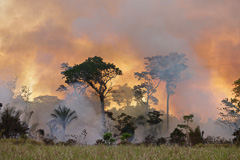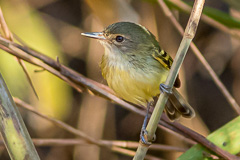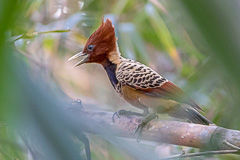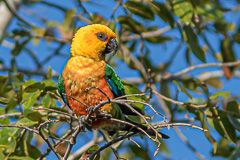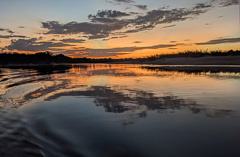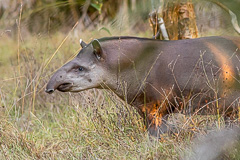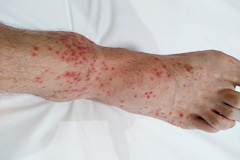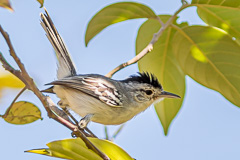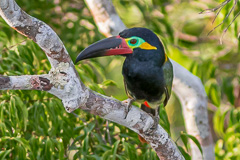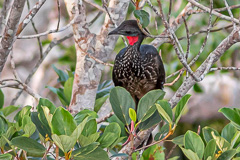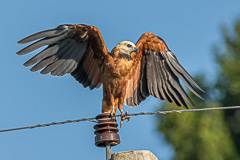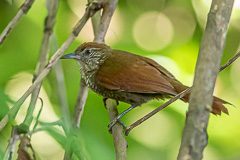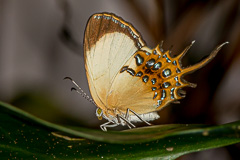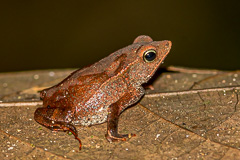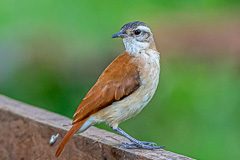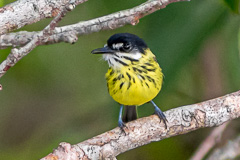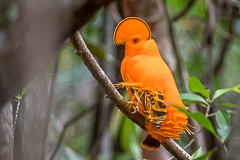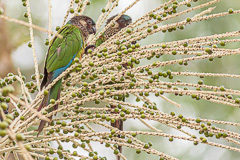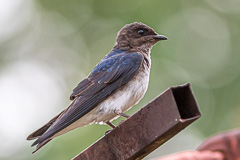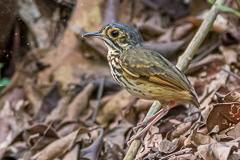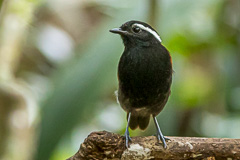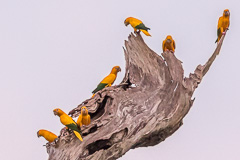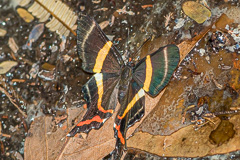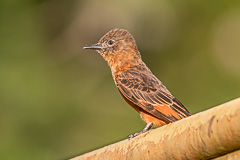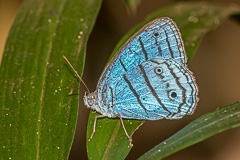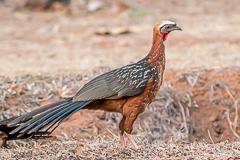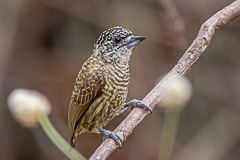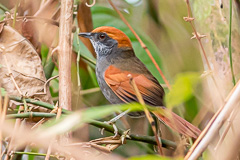Overview
Dates: |
27 July - 23 Aug 2023. |
With Mike Danzenbaker and Lee Hung. This trip was originally planned for 2020, but the Covid pandemic resulted in the dates being rescheduled three times. So it was with great relief that this trip finally came to fruition in 2023. Although we'd all birded extensively in South America and Brazil, none of us had birded Amazonian Brazil. Thus, our itinerary was based around a combined target list for that region, plus we added a few days in Tocantins specifically targeting Kaempfer's Woodpecker - a much sought after species. Logistics and guiding were arranged through Brazil Birding Experts, with the trip running smoothly, plus excellent guides.
Given our targets, and the number of sites to be visited, our itinerary was rather complex, involving several vehicles, various boats and ten domestic flights. It should be mentioned that internal flight schedules in Brazil are in dire need of a serious revamp, as it seems that awkward routing, lengthy connections and crazy arrival times are the norm; we spent inordinate amounts of time between connections. As we concentrated on target species, we had no expectation for recording a large trip list. Even so, we ended up with around 550 species in total. In general, other wildlife encountered was less than expected. Numbers of mammals, herps, butterflies and moths were quite disappointing compared to the birds. |
Due to the weather, birding was mostly restricted from dawn to 11:00 and 15:00 to dusk, with a siesta taken during the heat of the day. In summary, given the number of difficult target species, our trip was a great success and highly enjoyable, though it will long be remembered for one particularly large and painful dip.
Itinerary
26 - 27 Jul. A long journey Chiang Mai - Bangkok - Amsterdam - Sao Paulo, arriving late evening. The first overnight was spent at one of the airport hotels where, annoyingly, the vagaries of the electrical outlets in Brazil were discovered - with none of the adapters fitting. Despite various websites stating that standard European two-pin plugs will fit Brazilian electrical outlets, this is not really true. Only thin-pinned, two prong, non-recessed plugs are compatible. So, the first task the following morning would be to find an adapter. This, fortunately proved easier than expected at the airport.
28 Jul. Took the shuttle bus to the airport to meet with Mike and Lee, recently arrived from the USA. After lunch inside the terminal, we took the mid afternoon flight to Palmas, then a taxi, the 20 kilometres across town to our comfortable hotel for the night.
29 Jul. Given the excellent early breakfast buffet, it was probably fortunate we had an early departure, as given longer we'd have probably stocked up for the day. By 06:30 our local guide, André Grassi, collected us, and in the cool of the morning we headed to the cerrado in search of Kaempfer's Woodpecker.
Given that André had been studying these woodpeckers for years we were in good hands. However, having made a number of stops throughout the morning we failed to even hear any, though of course we did encounter a string of interesting species and targets which included Swallow-tailed Hummingbird, Red-legged Seriema, Ochre-backed Woodpecker, Santarem Parakeet, Barred Antshrike, Red-billed Scythebill, Smoky-fronted Tody-Flycatcher and Sibilant Sirystes. Due to extensive habitat clearance, especially in the last few years, within the woodpecker's limited range, this species has declined markedly - mostly due to the strong agricultural lobby in the country. This woodpecker is completely dependent on large stands of bamboo, which the locals see as a useless impediment, so vast areas are now cleared for soya and other bean crop growth. By midday, with the temperature approaching 40°C, we stopped for lunch, followed by a short siesta in Miranorte - our base for the night. By 14:30 we were out in the heat again, checking numerous sites for Kaempfer's Woodpecker. This time we struck lucky, with a group of four - two adults and young. Amazingly, even after studying this bird for 12 years André had never encountered a pair with two young. In the late afternoon, with cooling temperatures, we found both Eastern Striolated Puffbird and Gould's Toucanet. A return to town and another buffet spread. 30 Jul. Out at dawn, seeking other targets during a long walk in good habitat. Species found included Giant Wood Rail, Jandaya Parakeet, Santarem Parakeet, Ochre-backed Woodpecker, Rufous Casiornis and Ruby-topaz Hummingbird. Spending longer than expected, we simply ran out of time to look elsewhere for Fiery-tailed Awlbill. Then followed a five hour drive, on ever-deteriorating roads, to Canguçu. One has to admit Brazilians really love their potholes. We spent the last hour of light adjacent to the river and along the Beach Trail, with Bananal Antbird, and the pair of roosting Band-tailed Nighthawk. We really enjoyed Canguçu, for its remote location, simple but comfortable accommodation, great habitat and pleasant staff. |
Contrary to our expectation, electricity was available 24 hours a day, since the research centre had recently been connected to the main grid. One or two South American Tapir visited each evening, for corn placed out.
31 Jul. We hit the river at first light. During the morning we made several stops on Bananal island for specialities, including the undescribed Bananal Spinetail, although we failed to encounter Crimson-fronted Cardinal. We did have splendid views of Agami Heron though. With searing temperatures, we again took a midday break until about 15:00 when we headed down river again; this time successfully for Crimson-fronted Cardinal. As we'd headed a fair way downstream, the return journey, after dark. was accompanied by a spectacular sunset and a full moon, with at least five species of nightjar and nighhawk, including the sought after Silky-tailed Nightjar, views of which though were decidedly "better views desired". 1 Aug. In the early morning we again birded the Beach Trail and around the research centre. This was followed by three hours of washboarded and potholed roads as far as Lagoa da Confusão. Despite the 40°C temperatures we hit the scrubland in pursuit of our only real target here - Cinnamon-throated (Maranhao) Hermit, which eventually gave us OK. but brief, views. A single Lowland Tapir sauntered past seeming undeterred by our presence. Overnight at a nearby pousada, with sundowners on the river edge accompanied by a resident group of American Barn Owl and Band-tailed Nighthawk feeding over the river. 2 Aug. Sadly, today we discovered we'd been well and truly chiggered the previous afternoon. |
Having had success with the hermit yesterday we made an early start to drive back toward Palmas in an attempt to find Fiery-tailed Awlbill, but without luck. We did however obtain better but still brief views of Cinnamon-throated (Maranhao) Hermit, and a short detour gave us Caatinga Antwren. |
Lunch in Palmas then a drop off at the airport for our return to Sao Paulo. Despite our next destination, Manaus, being a two hour flight to the northwest of Palmas, domestic connections forced us to first fly two hours in the wrong direction to Sao Paulo, followed by a four hour flight to Manaus, where we arrived at 01:30 the following morning.
3 Aug. At 01:30, on exiting arrivals at Manaus airport, we were rather surprised to find that our expected pick-up was nowhere to be found, and contacting the Birding Brazil Experts office obviously didn't work at that time. However, just as we were about to find a taxi, since all passengers had left the terminal, a driver who'd been waiting, sauntered up to us with our names on his phone, asking if this was us. Well, it would hardly be rocket science that three lone foreigners, the only ones in the terminal, were likely whom he was looking for. Fortunately from here, only a short ride away, we thankfully checked into our hotel. After a couple of hours sleep and we were up at 05:00, to meet our guide, Pablo Cerqueira, take a quick breakfast and head to the Musa Botanical Garden on the edge of the city. The gardens here are located on the edge of the Adolpho Ducke Forest Reserve, and having arranged access to the 40 metre canopy tower we were in situ at sunrise. Over the next three hours we saw a range of specialities including Guianan Toucanet, Guianan Puffbird, Guianan Woodcreeper, Guianan Trogon and Marail Guan, plus a bonus group of the critically endangered Pied Tamarin. A late morning return to the hotel enabled us to catch up on sleep, amongst other things. Some heavy clouds and rain late afternoon and evening. |
4 Aug. Our first birding by boat was a 40 minute ride out to Marchantaria island. This area holds a number of specialities, with us successful in finding Black-and-white Antbird, Castelnau's Antshrike, Parker's Spinetail, Pearly-breasted Conebill, Short-tailed Parrot and Zimmer's Woodcreeper. By 11:00 we returned to the dock in Manaus, and sped our way on the four hour drive to Itacoatiara, where we overnighted in town.
5 Aug. Courtesy of local regulations, not permitting boats to depart pre-dawn, we managed a lay in till 06:00. Thereafter a five minute drive to the dock, followed by another 40 minutes by boat into várzea forest.
A successful morning, with Ash-breasted Antbird, Festive Parrot, Glossy Antshrike, Varzea Piculet and Scaled Spinetail. Following an excellent fish lunch, we drove the four hours back to Manaus. |
6 Aug. With the very recent rediscovery of Chestnut-headed Nunlet, not far from Manaus, today's birding had been rearranged at short notice to try for this bird. Since the bird had been found a second time, a few days previously, we were optimistic. Our promised 04:00 breakfast did not materialise, so we headed out for the 90 minutes drive to a different river access point, jumped into the boat for a further 50 minutes, again into várzea forest. Unfortunately, despite hearing the bird several times, we failed to see it, due mainly to not being able to penetrate its dense habitat by boat.
To say we were disappointed would be a major understatement given the scarcity of this species, and this once in a lifetime chance of being in the right place and the right time. After our return we took an hour's drive to Manacapuru. Late afternoon in the forest here proved exceptionally quiet, with little found, other than a few butterflies. All in all a pretty glum day. 7 Aug. Out at first light to the nearby Fiery Topaz lek, which did not disappoint. The rest of the morning was spent in the adjacent forest, mainly waiting for Crested Eagle to appear, which two birds did briefly, but not long enough for any photos. Around the accommodation were Pink-throated Becard and Sulphury Flycatcher. Then a short drive to Novo Airão. In the heat of the afternoon, not expecting anything much, we explored a nearby track through simple scrub, providing Blackish Nightjar and several hairstreak butterflies. Late afternoon we drove 30 minutes out of town to a stakeout for Rufous Potoo and White-winged Potoo. However, due to showers and imminent heavy rain, after 20 minutes waiting in the vehicle, we abandoned the idea hoping for better weather tomorrow. 8 Aug. A boat ride at first light, into black water várzea. A good morning with Amazonian Inezia, Ash-throated Antbird, Black-chinned Antbird, Slender-footed Tyrannulet and Wire-tailed Manakin. |
Lunch back at the hotel, followed by a snooze and a second attempt at White-winged Potoo and Rufous Potoo, with excellent views of the later, but only canopy flight views of the former.
9 Aug. The usual 05:00 start, up river about 50 minutes, to Vermelinho - a private forest run as a rustic resort and forest reserve. All morning was spent on the main trail, targeting Pearly Antshrike, which was easy to hear but an absolutely terrible bird to locate and see well, as rather ventriloquial and shy. Other species encountered included Rusty-breasted Nunlet, Black-chinned Antbird, White-cheeked Antbird, White-crested Spadebill and White-chested Puffbird. After an excellent lunch at the camp, a second walk produced Brownish Twistwing - another difficult to see species. A late afternoon return to town. 10 Aug. Early morning along a track in scrubby forest near town, Around 09:00 conditions became ominously dark and we were caught out in the rain, beating a retreat to our vehicle. During the remainder of the morning, with easing rain, we managed a few sorties along the main access track, encountering Amazonian Antshrike, White Hawk, Double-toothed Kite and Common Scale-backed Antbird. A flowering tree at our accommodation held migrant Small-billed Elania, Golden headed Manakin and White-crowned Manakin. Lunch, followed by a drive through heavy rain back to Manaus. En route we stopped a while at Iranduba, for Sand-coloured Nighthawk, Spot-breasted Woodpecker and White-throated Kingbird. |
11 Aug. A very early, 03:30 departure, in order to arrive at the Z2 tower in Cuieiras Forest Reserve pre dawn. Logistics to visit this tower are somewhat convoluted as it's necessary to seek permits, be accompanied by a local guide and have mandatory insurance. A good, high clearance 4x4 is also essential for the last kilometre inside the forest to the base of the tower. Even in the height of the dry season the track was a quagmire of mud and goo. Breakfast in the field, then up to the canopy from 05:50 - 09:30.
We had a good haul of specialities, though missed the much wanted Dotted Tanager and Crimson Fruitcrow. Still, we were happy with Chapman's Swift, Dusky Parrot, Guianan Tyrannulet, Guianan Puffbird, Painted Tody-Flycatcher, Pompadour Cotinga and Todd's Syrestes. From here it was an hour or so to Presidente Figueiredo, where we checked into the Pousada Aldeia Mari, for a three night stay. Seemingly modelled on Fawlty Towers, just about everything from aircon units, to water supply, internet and room keys were a constant source of chaos and confusion. |
From a birding perspective one can see the attraction, due to the Guianan Cock-of-the-rock and Capuchinbird leks, plus good adjacent forest, but the maintenance and management here needs a rocket. After a couple of hours on our first aircon fiasco we hit the forest, finding Blue-backed Tanager and Marail Guan.
12 Aug. Pre dawn, Spectacled Owl was calling. Our day started with a 45 minute drive to a forest trail, after which we walked the longer Neblina Waterfall trail. Disappointingly quiet, though we did manage Red-billed Woodcreeper and Sapphire-rumped Parrotlet. After lunch at 14:30 we walked to the Guianan Cock-of-the-rock lek where the birds are totally fearless of people. About a dozen males were hanging out, though without a female, activity was subdued. We then took a side trail to the Capuchinbird lek which was the total opposite, with these birds rather flighty and shy. Note that this walk, due to some rock-hopping, is not suitable for anyone with mobility issues. Thunder and rain threatened late afternoon but came to nothing. |
13 Aug. Exploring local forest adjacent to our accommodation, we finally ran into our first decent feeding flock of the trip - Rufous-rumped Foliage-gleaner, Chestnut-rumped Woodcreeper, Dusky throated Antshrike, Wedge-billed Woodcreeper, Long-winged Antwren, White-flanked Antwren, Slender-billed Xenops and Saffron-crested Tyrant Manakin.
During the morning we also found White-fronted Manakin, which took some time to see well. After lunch, at Fawlty Towers, the local trail finally provided us Pelzeln's Tody-Tyrant and Guianan Schiffornis - the latter giving an us a huge runaround. An excellent bonus was Grey-winged Trumpeter. 14 Aug. En route to Manaus we made an early stop at Iracema Falls, finding the excellent Crimson Topaz, Sulphury Flycatcher and Painted Parakeet. Having dropped the vehicle at the airport we took the afternoon flight to Itaituba. Here we picked up our local guide and driver, complete with enormous Ford 4x4. Logistics at Itaituba are again tricky. Since roads are unpaved, and no car rental company rents 4x4 vehicles, this necessitates renting privately, since any wet weather would make the roads impassible to standard saloon vehicles. Being the height of the dry season, rain was not an issue for us, but the dust thrown up by passing vehicles made roadside birding very unpleasant. From town, it was a short one hour drive to our simple pousada, situated on the bank of the Tapajos river. Ladder-tailed Nightjar was calling from the garden. 15 Aug. With only a ten minute drive to Amazonia National Park we were out birding by first light. During the morning we walked an excellent two kilometre loop trail through good quality terra firma forest. Although long spells were relatively birdless, quality made up for quantity, with Hoffmann's Woodcreeper, Saturnine Antshrike, Grey Antbird, Vulturine Parrot, Elegant Woodcreeper and Band-winged Antbird. Mid afternoon we birded the park headquarters area, and a different, nearby trail. One of the highlights of the trip was 30 minutes in the company of the spectacular Alta Floresta Antpitta. The last hour of light was spent by the roadside, hoping for Golden Parakeet. However, they were not to be, so we simply became covered in dust from passing trucks. 16 Aug. A longer 40 minute drive into the park, followed by a 40 minute walk to a Black-bellied Gnateater stakeout. Definitely another candidate for bird of the trip. We also encountered the hard to see Cryptic Forest Falcon, but little else in four hours along the trail. Lunch back at the accommodation, then a return to the same area as yesterday, with Ruddy Spinetail and Harlequin Antbird. Another late afternoon dust session without parakeets. 17 Aug. Unfortunately, another early attempt for Golden Parakeet was unsuccessful, though we did find White-tailed Cotinga, Hauxwell's Thrush and Flame-crested Manakin during the morning. As we'd now totally dipped on the parakeet over the last two plus days it was time for plan B. This involved a two hour drive at breakneck speed, across and beyond the park, to a known evening roost site. The site itself is not at all salubrious, and with the locals doing a massive forest burn, we were not exactly optimistic about our chances. However, just after sunset a group of 16 Golden Parakeet did indeed come to roost and were very welcome. Wing-barred Seedeater was also a nice surprise. With a reverse two hour drive, we arrived fairly late back at the pousada. 18 Aug. Due to a long, and convoluted, transfer to Parauapebas, the gateway to Carajas, the next two days were effectively a birding write-off. A veritable lay in till 06:30 when we left for the airport, said our thanks to the local guide and driver, and took the one hour flight to Manaus. With an 11 hour stopover we simply checked into a hotel and caught up with trip notes and photo processing. A late evening flight to Belém, where we arrived at another airport hotel by 01:30 the following morning. |
19 Aug. A mid afternoon flight to Parauapebas, where we met up with local guide Filho. Overnight in town.
20 Aug. After two days it was great to be back in the field! Our first birding was along a couple of excellent trails in terra firma forest close to the airport, with highlight Para Foliage-gleaner and Blue-necked Jacamar. |
Another very hot day, during the heat of which we simply birded from patches of shade around the small town inside the forest reserve, with Cliff Flycatcher exceedingly tame.
Late afternoon we birded one of the river trails with Xingu Scale-backed Antbird and Guianan Woodcreeper, but dipped on Black-chested Tyrant. On our return walk, after dusk, Blackish Nightjar seen well. 21 Aug. Although Carajas is a national forest, and hence a protected area, a large part of it is designated as an open cast mining concession. This necessitates yet more permits and permission. Today we started with a two hour drive across the concession to the Claras Research Station. Some excellent species this morning, including Guianan Red Cotinga, Dot-eared Coquette and White-crested Guan. During the afternoon we tried for the undescribed Amazonian Spinetail, without success. Late afternoon in scrub around the town, with Spectacled Thrush and Chestnut-headed Chachalaca. 22 Aug. Another longish 90 minute drive across the concession to the White Bellbird lek - although this species displays, and calls high in the canopy, the piercing sound and the bird's impressiveness made this another trip highlight. We then spent several hours searching for Ochre-cheeked Spinetail, lucking in on Russet-crowned Crake in the process, plus surprisingly our first Rufous-collared Sparrow of the trip. Mid afternoon, another failed attempt for Black-chested Tyrant. |
23 Aug. Our final morning was spent at some forest fragment outside town, near Tapete Verde. Here we finally managed to catch up with Amazonian Spinetail, plus brief glimpses of Black-chested Tyrant. During the morning we also came across Bar-breasted Piculet, McConnell's Flycatcher, Slate-coloured Seedeater and Thrush-like Wren. |
Additionally, we had good views of a troupe of Red-bellied Titi Monkey. A late afternoon flight to Belo Horizonte, with connection to Sao Paulo, with us eventually making the hotel by 01:00.
24 Aug. A late evening flight to Europe, two hours delayed. All in all a very successful trip and highly recommended.
Species List
Galleries
Bird images from this, and other, birding trips.

